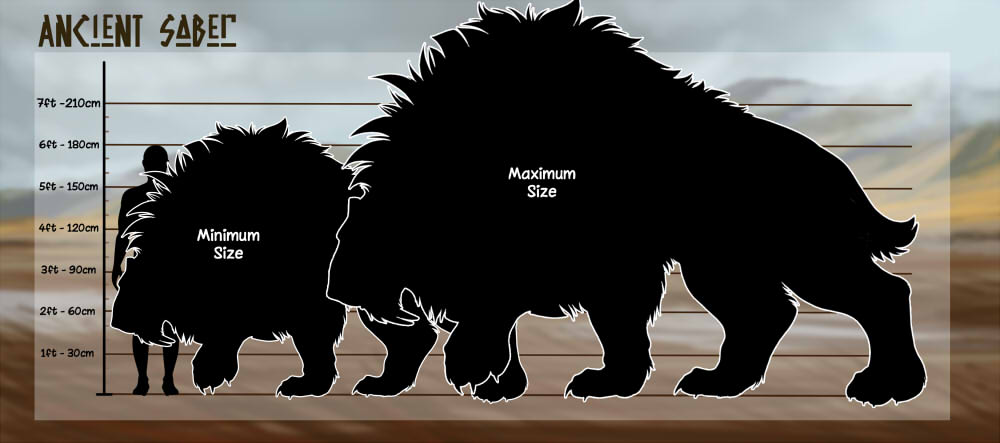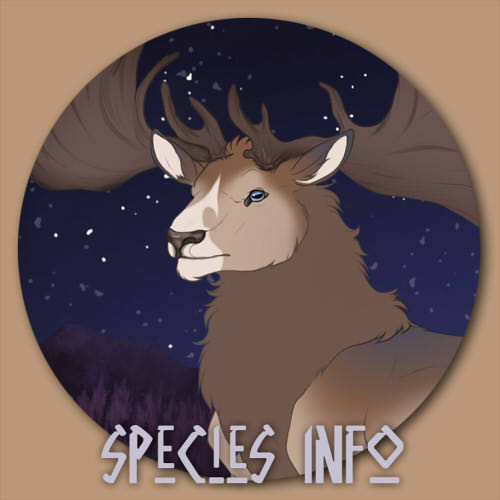
Welcome!
Prehistoria is home to many creatures, but only a few are bold and strong enough to be befriended or tamed. This is a breakdown of the creatures that you can acquire. More will be added as the game progresses.

Note: While we do have the average sizes for each species listed, we are not overly strict with them. It is entirely okay to make your beast up to 20 cm / 0.65 ft smaller or larger than the min / max size given or, if your beast uses magic to “fake” its height, up to 50 cm / 1.65 ft smaller or larger.
Important: When using magic the “original” size of your beast will still be within the range as the magic is only allowed to make it appear larger. Magic cannot actually make your beasts’ body grow larger or smaller!
The height ranges were only added to give an impression on how large the different species are and to help if someone wants to give their beasts an “official” height on their Import. We will not judge beasts’ sizes in images / literature as long as it is logical (an Equus cannot be bigger than an Ursus, etc).

Regular Beasts: Saber
The Sabertooth (also simply called Saber) is a large species of cat and have large, knife-like teeth, and specialized jaw hinges that allow for a gape of almost 120 degrees. Sabers are massive cats, with a height range of 4.5 to 6 feet at the shoulder, making them easily one of the largest felines.
Sabers are social cats, living in large prides with variable hierarchies, though lone cats are not uncommon. A group of sabers at full strength can take down basically anything they choose to, while single animals are capable of tackling prey their size or slightly larger.
The hunting style of the saber consists of a prey item being wrestled into submission, and then choked with a throat bite. Rarely do sabers go in teeth first, as the fangs are laterally flattened and can shatter easily if they hit bone or are struck from the side.
Saber vocalizations are limited to deeper sounds, on account of their sheer size. Loud territorial roars are common, as well as a variety of moans and chuffs.
Quick facts:
Diet: Carnivorous
Litter Size: 1 – 4 Cubs
Height Range: 4.5 – 6 ft (1.35 – 1.8 m) at the shoulder.
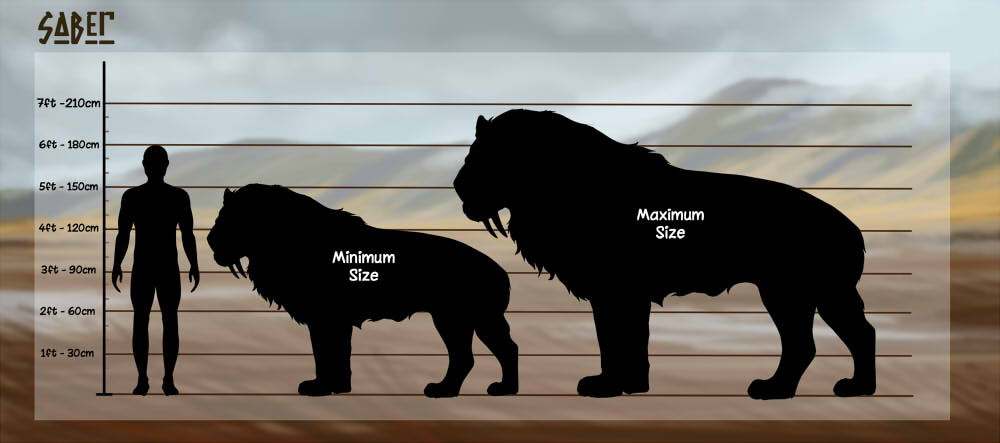

Regular Beasts: Dire Worg
The Dire Worg is a large wolf-like carnivoran. While its features are very canine, it is actually a relative of hyenas. That said, worgs are not true hyenas, and differ in many physical and behavioral aspects. Worgs are robust animals, with powerful necks and sloping backs, and average a height range of 4 to 6 feet at the shoulder.
Worgs usually live in large, loose-knit packs, where individuals care for one another. Whether or not there is a strictly adhered to hierarchy depends on the culture of the group; some packs have a clear chain of command, and some do not.
Together, a worg pack can compete directly with saber prides for territory and hunting grounds, as worgs packs and saber prides both feed on large prey. Lone worgs are less common, but present; usually specializing in smaller, bite-sized animals.
As intensely social animals, worgs have a wide repertoire of vocalizations, ranging from wolf-like howls and barks, to hyena-like rally whoops and cackles, as well as grunts, groans, growls, and whines.
Quick facts:
Diet: Carnivorous
Litter Size: 1 – 4 Pups
Height Range: 4 – 6 ft (1.2 – 1.8 m) at the shoulder.
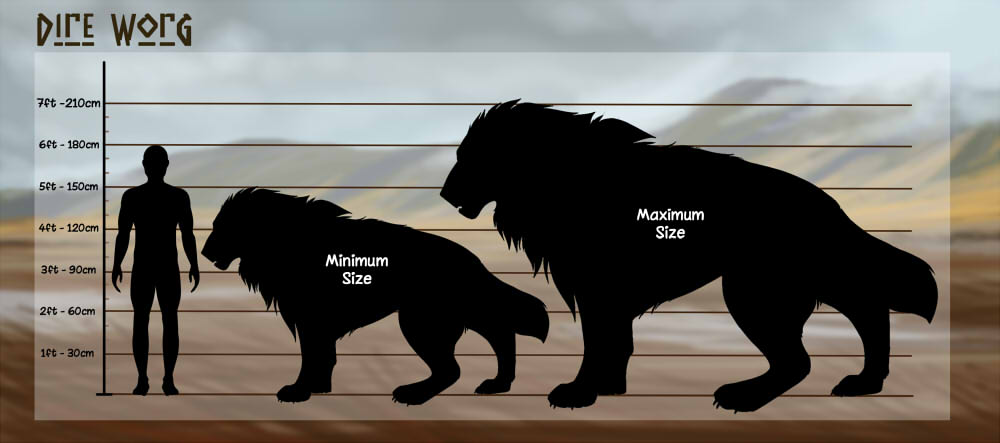

Regular Beasts: Equus
The Equus is a average-sized member of the horse family, and is characterized by a stiff mane of standing hair, and 3 toes on each foot. Their hight ranges from 4 to 5 feet at the shoulder.
Equus exhibit the typical herd lifestyle of the horse family; with a lead stallion and lead mare being the core of a larger group of females and their young. They are very social, forming lasting friendships and bonds. Stallions will often attempt to ‘poach’ mares from other herds, sometimes resulting in shockingly violent fights between the rival males.
Equus are commonly preyed upon by wild worg packs and saber prides, but domesticated individuals of all species have been noted to get along at times. Their diet consists mainly of the different plants and grasses found in their living areas, however if they live together with humans it can include food like grain, carrots and various other things as well.
Equus make a variety of sounds, from snorts and brays, to whinnies, nickers, and even roar-like screams.
Quick facts:
Diet: Herbivorous
Litter Size: 1 Foal
Height Range: 4 – 5 ft (1.2 – 1.5 m) at the shoulder.
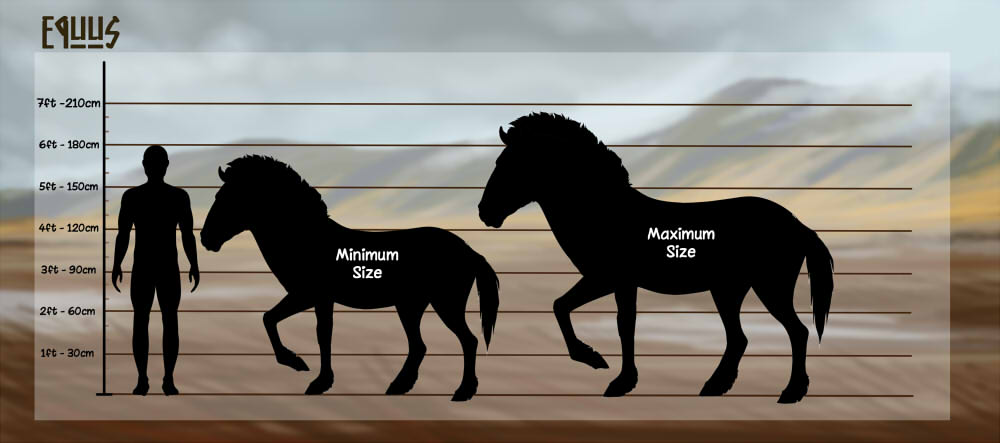

Regular Beasts: Ursus
The Ursus is an enormous bear, somewhat reminiscent of the short-faced bears in size and predatory habits, but is nonetheless a relative of polar and brown bears. Their average height reaches from 5 to 7 feet at the shoulder.
Ursus lifestyles are highly variable, unlike most bears. Some individuals live the typical cycle of hibernation followed by a spring and summer of gorging, while others remain active year-round. As highly intelligent animals, they have been known to form beneficial partnerships with lone worgs and with people. Rarely, they have been sighted in the company of rogue sabers, and even tailing tolerant equus herds.
Adaptable and intelligent, ursus are known for their ability to take advantage of almost any food source they come across; large prey, small prey, berries, grass, fish, moths, anything is fair game.
Ursus are not particularly vocal animals, but do produce hoarse, guttural roars when fighting other animals. Conflicts with other bears are also accompanied by gaping jaws, gnashing teeth, and mock charges. Cubs make a distinctive squalling noise when calling to their mothers.
Quick facts:
Diet: Omnivorous
Litter Size: 1 – 2 Cubs
Height Range: 5 – 7 ft (1.5 – 2.1 m) at the shoulder.
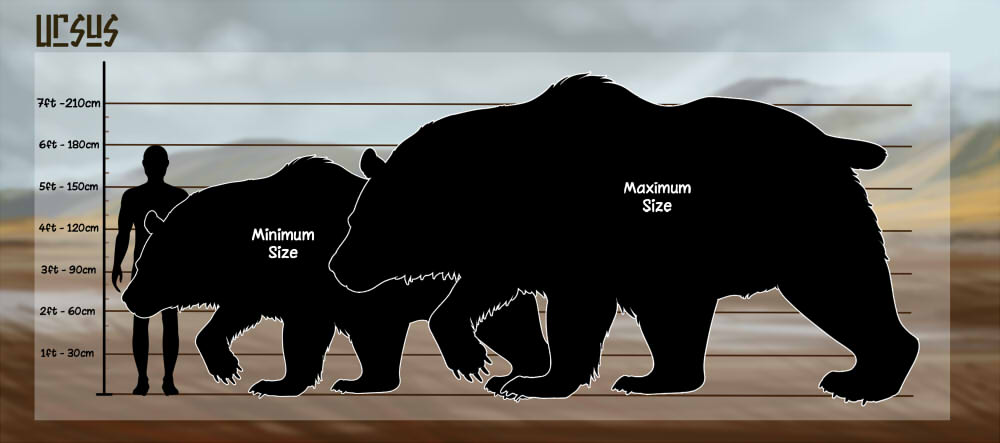

Regular Beasts: Megaloceros
The Megaloceros is a large deer with an heavy dimorphism between males and females. Females have an average height of 5.5 to 6 feet at the shoulder. In comparison, males have an average height of 6 to 7 feet at the shoulder, a more fluffy neck and, most noticeable, large antlers on top of their head with an average span of 12 feet from tip to tip.
Male and female Megaloceros’ normally live in segregated herds due to different needs in nutrition. As soon as the rut season starts in autumn the bulls will fight against each other to impress as many cows as possible. Once it’s over they will go seperate paths again. It is possible to find Megaloceros in or around human settlements as well.
Their diet consists mostly of fresh foliage. Due to their antlers male Megaloceros need a lot of protein and minerals as well which can sometimes be hard to find. It is also quite common for them to eat tree bark or young sprouts. If living together with humans their diet can expand and contain food like grain as well. Thanks to their size the biggest danger for them are humans or large predators like Sabers and Dire Worgs.
Megaloceros have sounds for various situations. In social situations like calling their young or “talking” with others they mainly use grunts and bleats. During the mating season males are known to use sounds to intimidate their rivals: grunts or snort-wheezes for example.
Quick facts:
Diet: Herbivorous
Litter Size: 1 Calf
Height Range: 5.5 – 6 ft (1.65 – 1.8 m) for females, 6 – 7 ft (1.8 – 2.1 m) for males at the shoulder.
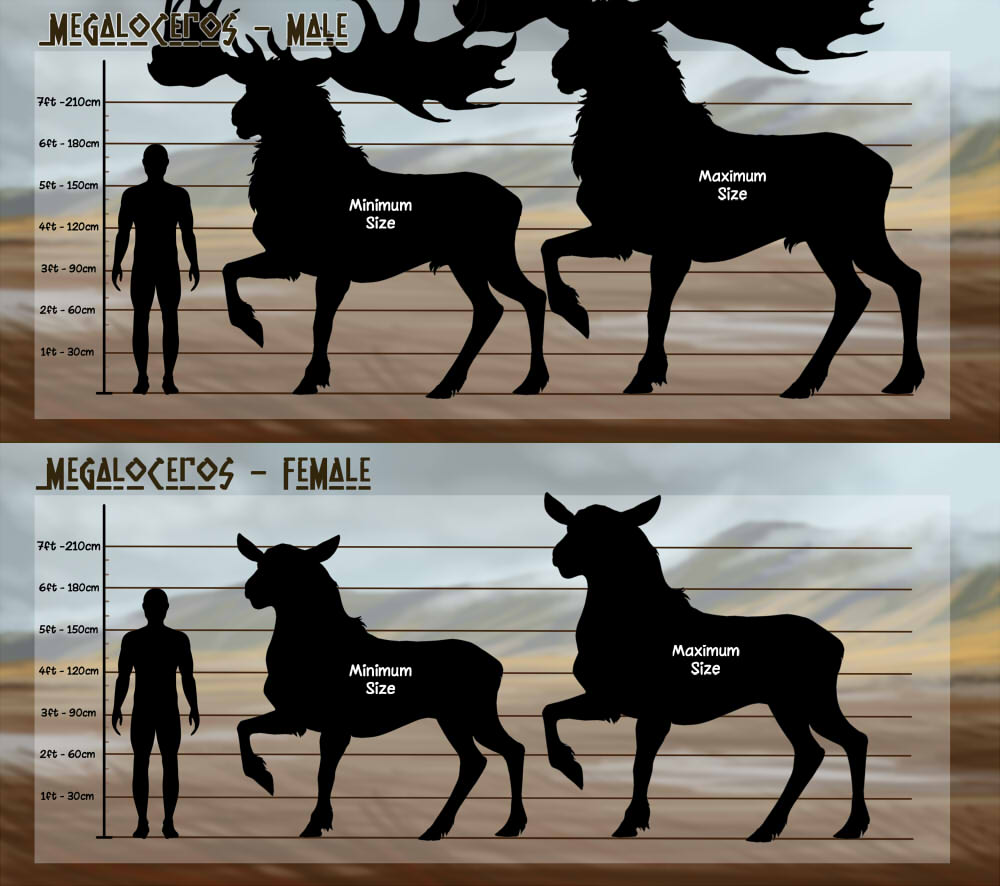

Regular Beasts: Terror Bird
Terror Birds are large and fearsome birds which have an average height of 5.5 to 6.3 feet at their shoulders. Their head is rather big, has a small crown of larger feathers on top and ends with a sharp hook on their beak comparable to beaks of modern day birds of prey. The body is covered in only small feathers and due to having only very small wings compared to their body size, they are unable to fly.
Normally Terror Birds either live by themselves or together with their partner. During the mating season they can be seen in pairs more often and occasionaly in small family groups of up to 4 birds staying together until their chicks are big enough to leave and start their own journey.
While they can be described as omnivorous, the by far largest part of their diet consists of meat. Due to their long legs they are capable of running incredibly fast and their strong beak helps catching their prey as well. Their main prey consists of smaller to medium sized animals and fish. Plant based food is normally only consumed if the bird lives together with humans and gets their food from those.
Not much is known about the sounds they make, however it’s suspected they made clacking sounds to communicate with each other.
Quick facts:
Diet: Omnivorous
Litter Size: 1 – 4 Chicks
Height Range: 5.5 – 6.3 ft (1.65 – 1.9 m) at the shoulder.
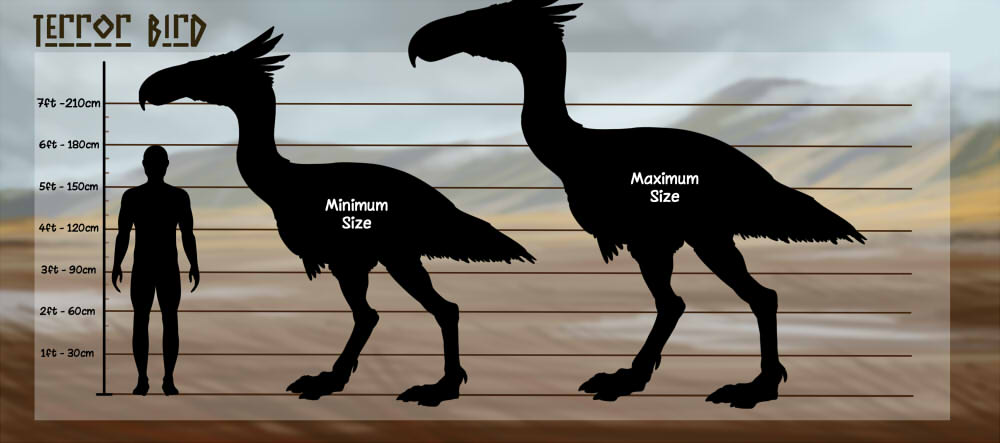

Regular Beasts: Woolly Mammoth
Mammoths are the biggest roaming beasts within Prehistoria, commonly seen in large herds called a ‘Memory’ that consists of 20 to 60 mammoths. These Memories are all led by a single member; a Matriarch. They are the oldest and the wisest of the herd and they use their knowledge to better their herd and keep them safe. Typically, when a Matriarch gets too old, one of her daughters or nieces will adopt the rank of Matriarch.
Male mammoths, however, will leave a Memory once they reach maturity. Sometimes by choice, other times they are driven away by the adult male that protects the Memory. Even when a male mammoth has his own Memory, they don’t always stay and will roam. They will stay for a short period to help protect young calves but more often than not, the males will get bullied and pushed away by the females of the herd out of concern for the calves’ wellbeing.
A mammoths’ tusks can grow up to 16 feet long and are primarily used to attract mates or defend themselves and others from predators. And as an empathetic species, mammoths are known to protect other smaller creatures from predators – especially predators that the Memory remembers hunting their own.
Their fur consists of two layers, a soft layer beneath a coarse outer layer that helps them keep warm even in the harshest of winters. And Mammoths don’t always trumpet to communicate to their Memories; they can bellow and rumble with different volumes to vocalise concern or comfort.
Mammoths are also known for their memories; for some this is a good thing. For others that seek to hurt them, maybe not.
Quick facts:
Diet: Herbivorous
Litter Size: 1 Calf
Height Range: 9 – 11.5 ft (2.75 – 3.5 m) at the shoulder.
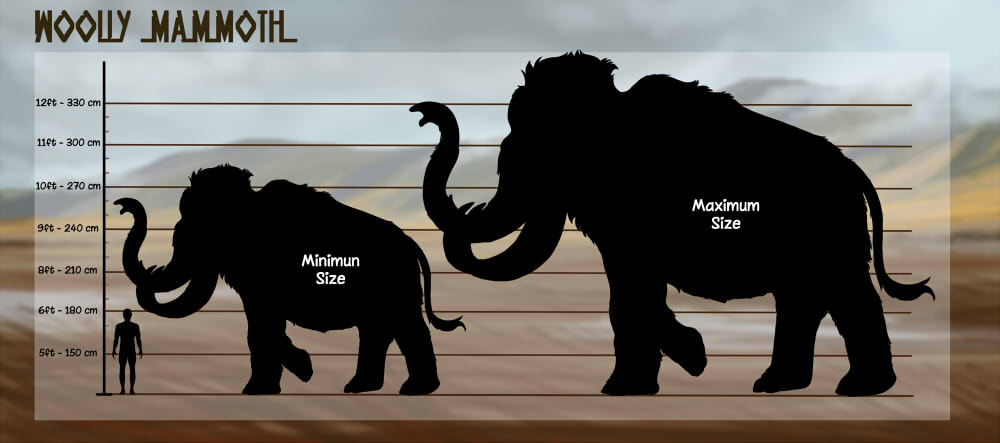

Ancient Beasts: Saber
When Arwii created the mortals, the Sabers as we knew were different looking: An ancestor of both Regular and Ancient Sabers. After K’Malou split the lands, these proto Sabers’ evolved into regular Sabers on the mainland and into Ancient Sabers on Tetlcuamiztli Island, the latter looking similar to their ancestor, hence the “Ancient” in their name.
Despite sharing the same ancestor, Regular and Ancient Sabers can’t breed together and no pregnancies are issued from these unions.
Ancient Sabers are the absolute apex predators of Tetlcuamiztli Island and know no predators themselves. Their massive and powerful jaws can break bones very easily, making them especially successful at hunting big preys. With their great size they are full of raw strength, but not very agile and fast. Their hunting technique is heavily relying on stalking their prey and using their strength to pin them down before giving the killing blow.
While Regular Sabers can live together in a pride, Ancient Sabers are more the loner type, only actively seeking temporary partners during mating season. However, tamed Ancient Sabers show more pride behaviour than their wild fellows.
Ancient Sabers give birth to only one cub per litter and are very slow to grow. A cub usually stays with their mother until they hit 3 or 4 years of age. Which is a reason why the species is so rare and elusive, with how much time a female needs to bring her only baby to full adulthood and independence.
Knowing this, Female Ancient Sabers are instinctively more aggressive than males. Orphaned Ancient Saber cubs below 2 or 3 years of age can die quickly if not rescued or adopted immediately. Child mortality is unfortunately quite common and makes the species even more rare and elusive.
Sounds wise they can chuff, roar, grunt and moan. But they also have a rumbling sound so deep it’s inaudible to human’s ears.
Quick facts:
Diet: Carnivorous
Litter Size: 1 Cub
Height Range: 5 – 7 ft (1.5 – 2.1 m) at the shoulder.
